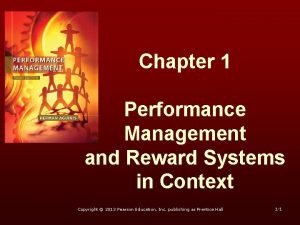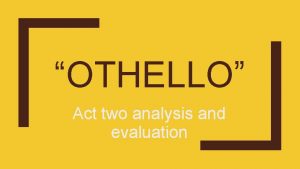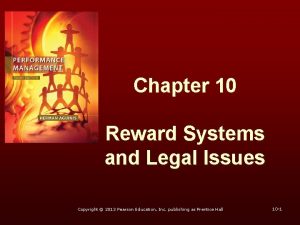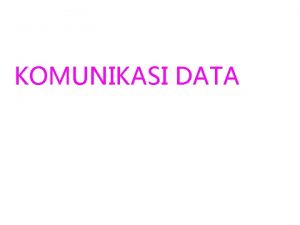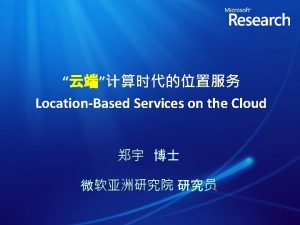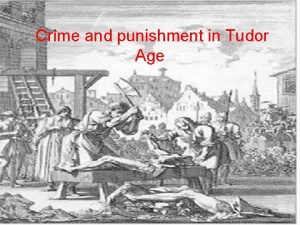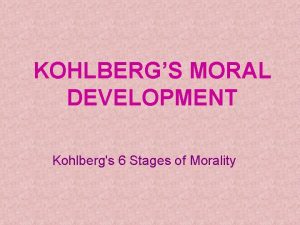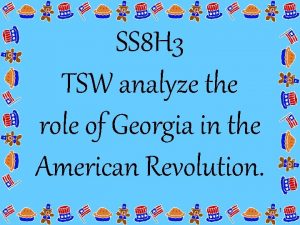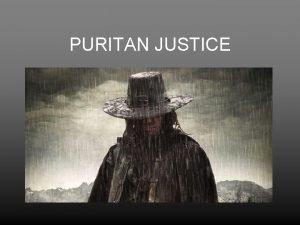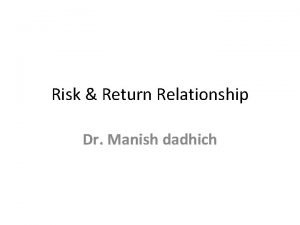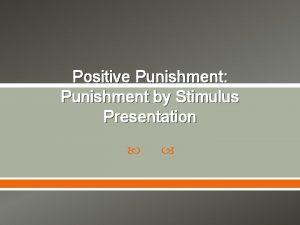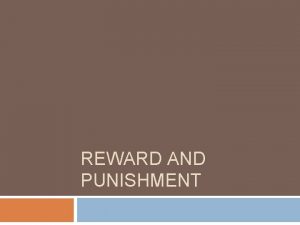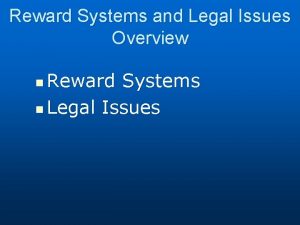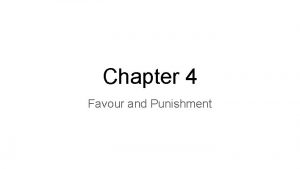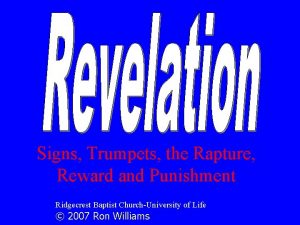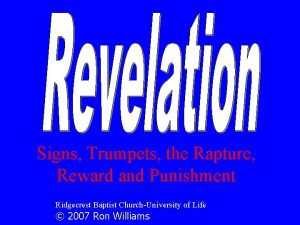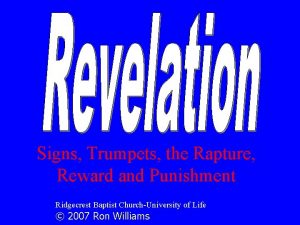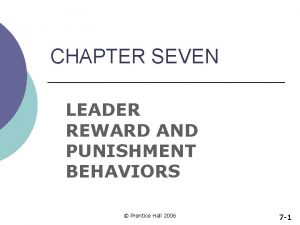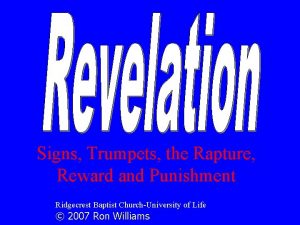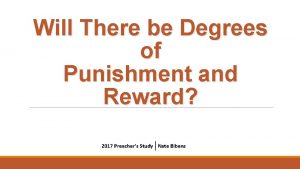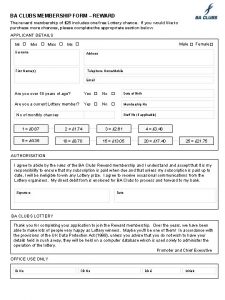Reward and punishment mechanism for research data sharing





























- Slides: 29

Reward and punishment mechanism for research data sharing Jinfang Niu University of Michigan

Concepts and Definitions Research data Data created by scientific researchers primarily for research purposes. Data created primarily for commercial, clinical or administrative purposes, such as user purchase history, patient medical records, or government records are excluded.

Data sharing for collaboration Very large data sets A researcher has collected data, but he/she doesn’t have enough time or capability to analyze the data. One researcher’s data can be used to address some research questions that he is not interested in.

Data sharing for reuse Data have value beyond the purpose for which they were originally collected. Reused for Verification Replication Different research questions Meta-analysis Decision making & information Teaching

Sharing through archives Funding agency Producers (prepare & deposit) Archive (process & disseminate) Users

Publicly funded research data are public goods Non-rivalry: one individual’s use of the data does not reduce the amount available for other people. Not-excluded: no one is excluded from the online data archive whether or not they deposited data.

Theories about public goods Free-riding in the voluntary contribution to public goods tends to be the dominant strategy in a non-cooperative game. The achievement of a pareto - optimal via decentralized methods in the presence of public goods is fundamentally incompatible with individual incentives.

Beyond public goods For normal public goods contributors benefit the same as free-riders. Contributors are not harmed from their contributions In data sharing The benefit of data preparation largely goes to the users. Assumption: It is not very likely that a data depositor uses his own data deposited into a data archive Data producers might be harmed by sharing data.

Incentive mechanisms implemented NIH In the case of noncompliance, NIH can take various actions to protect the federal government's interests. In some instances, NIH may make data sharing an explicit term and condition of subsequent awards. It does not offer rewards for doing well in data-sharing plan. ESRC The final payment of an award will be withheld until data has been deposited in accordance with the requirements. The requirements of the data sharing policy are now a condition of funding. Both: citation of data is not mandatory, co-authorship is not allowed as a condition for sharing data.

Producers’ expectations Some sort of acknowledgments for data deposit, such as a certificate If data deposit is mandatory to receive new funding, or a prerequisite for publishing a paper derived from the data … Some grantees are strongly against punishment ---- From survey data

A simple math model Purpose: to show the effects of punishment and reward. Punishment: the data producer will be punished if the effort he spent on data preparation is lower than a threshold. Reward: when the deposited data is used, the producer of the data gets a reward.

Model set-up A data producer: has total fund P chooses for research Chooses e for data preparation (P = + e) benefits ( ) ( ’( ) >0) from research Assumptions ( ) is concave, and ’( ) >0 The data producer always tries to maximize his benefit.

No reward & no punishment Data producer: Choice: e = 0 Maximized benefit: (P) User: no data to use, benefit: 0 Social benefit: (P)

Punishment only Producer: If e >= e’, benefit: ( ) = (P-e), max: (P - e’) If e < e’, benefit: ( ) – f, (f>0), max: (P) – f

When Ω(P - e’) > (P) – f The data producer would meet the threshold to avoid the punishment. Two explanations: The punishment is severe enough. The threshold is easy to meet. When Ω(P - e’) = (P) – f The data depositor is indifferent between getting punished and meet the threshold.

When Ω(P - e’) < (P) – f The data producer would choose not to prepare data and get punished. Two explanations: the punishment is not severe enough the threshold is too costly to meet. Conclusion: In the punishment only scenario, data producer’s benefit is max [Ω(P - e’), (P) – f].

User when the data producer would rather be punished, benefit: 0. Social benefit: (P) Max [Ω(P - e’), (P) – f] = (P) – f. The data producer loses f, but the funding agency gets f. : (P) – f +f +0 = (P). Too weak punishment or too high a threshold for punishment is not effective.

When the producer chooses to meet the threshold, The user would use the data with probability (e’) ( ’( e) > 0, ( 0) =0). Expected benefit: v * (e’) Social benefit: Ω(P - e’) + v * (e’) Max [Ω(P - e’), (P) – f] = (P - e’) when (P) < Ω(P - e’) + v * (e’), the punishment and threshold are effective. When (P) > Ω(P - e’) + v * (e’), the punishment and threshold are not effective.

Reward only When the deposited data is used, the producer gets a reward r. The deposited data has a probability (e) ( ’( e) > 0, ( 0) =0) of being used. Producer benefit: ( ) + r * (e) <=> (P-e) + r * (e).

If there is a value of e which makes [ (P-e) + r * (e)]’ = 0 <=> r * ’(e) = ’(P-e), the producer’s benefit is maximized when the marginal benefit of spending an additional amount of funding on research is equal to the product of reward and the marginal probability of being used.

If the reward(r) is so big that r * ’(e) > ’(P-e) is always true, the data depositor would spend all funding available on data preparation. The utility is maximized when e = P If the reward is so small that r * ’(e) < ’(P-e) is always true, the data producer would not deposit data and there is no data to use. The producer’s benefit is maximized when e=0 The social benefit is (P ). The small reward is not effective.

Suppose the producer’s benefit is maximized at e = e*, User’s benefit: v* (e*). Producer’s benefit: (P-e*) + r * (e*), The funding agency: - r * (e*). Social benefit: (P-e*) + v* ( e*). (P) < = (P-e*) + v* ( e*), reward causes at least as much social benefit than no reward & no punishment. Warning: do not make the reward too big or too small.

Characterize punishment and reward u Punishment Coercive and uniform Pros and cons: Makes all data accessible to the public. All data producers have to prepare and deposit data to avoid punishment even if their data sets are not likely to be used.

Cumulative and Average Monthly Access Rates for the 10 Most Frequently (Top 10) and 10 Least Frequently (Bottom 10) Accessed Data Sets. Cumulative Average (per month) Top 10 Bottom 10 5185 27 1037 3 2345 25 260 2. 8 2234 24 319 2. 7 1651 24 183 2. 7 1623 23 232 2. 6 1328 21 148 2. 3 1267 20 271 2. 2 1229 16 137 1. 8 932 14 104 1. 6 851 11 95 1. 2


u Rewards Inducive and selective Pros and cons: Related to the actual use of data Difficult to anticipate actual use. Not all data are accessible to the public

Conclusions Publicly funded research data are public goods. They have some features beyond public goods that make free - riding even more attractive under voluntary contribution. Incentive mechanisms should be available to encourage data sharing Punishments or rewards need to be carefully decided to avoid un - intended consequences

Thanks! This research was supported by the National Science Foundation (NSF Award Number IIS-0456022) as part of a larger project entitled “Incentives for data producers to created archive-ready data sets. ”

 Performance management and reward system
Performance management and reward system Act 2 othello summary
Act 2 othello summary Reward system and legal issues
Reward system and legal issues Managing employee performance and reward
Managing employee performance and reward Celebrating performance accenture
Celebrating performance accenture Komunikasi data merupakan gabungan 2 macam teknik yaitu....
Komunikasi data merupakan gabungan 2 macam teknik yaitu.... Sharing data
Sharing data Data sharing in dbms
Data sharing in dbms Criminology unit 4 revision
Criminology unit 4 revision Crime and punishment revision guide
Crime and punishment revision guide Characters of crime and punishment
Characters of crime and punishment Tudor punishment for stealing
Tudor punishment for stealing Criminology unit 4 crime and punishment
Criminology unit 4 crime and punishment Medieval crime and punishment facts
Medieval crime and punishment facts Good boy morality
Good boy morality Edexcel gcse history crime and punishment exam questions
Edexcel gcse history crime and punishment exam questions Kahoot crime and punishment
Kahoot crime and punishment Crime and punishment in medieval japan
Crime and punishment in medieval japan Crime and punishment 1750 to 1900
Crime and punishment 1750 to 1900 Effectiveness of social control inside prisons
Effectiveness of social control inside prisons Crime and punishment key words
Crime and punishment key words Crime and punishment topic
Crime and punishment topic Wjec criminology unit 4
Wjec criminology unit 4 Tsw crime and punishment
Tsw crime and punishment Puritanical methods of punishment
Puritanical methods of punishment Thesis statement about the death penalty
Thesis statement about the death penalty Reward from god
Reward from god Where is the reward center of the brain
Where is the reward center of the brain Keuntungan join multibeauty
Keuntungan join multibeauty Dadhicha system
Dadhicha system
